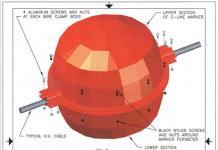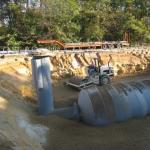If a person lives in a private house or has a garden plot, then having a stationary circular saw in the arsenal of a home craftsman is not only desirable, but sometimes necessary. Unfortunately, the cost of an industrially manufactured sample of such a saw does not correspond to the frequency of its home use, and for some Russians it is simply unaffordable. At the same time, making a “circular” with your own hands is quite simple, using the drive of a sewing machine or a regular electric drill. However, the quality of work performed and the range of operations performed largely depend on the bed of the circular saw.
Bed design
The simplest circular saw frame, the drive power of which does not exceed 0.8...12 kilowatts, is quite easy to make with your own hands from thick plywood and wooden blocks. For the drive, you can use an electric drill “BOSCH GSB 19-2” (power 0.85 kilowatts) or “DWT SBM-1050” (power 1.05 kilowatts), which is attached to under the stove using a special bracket. The length of the bed will depend on the length of the material being cut. For the table, you must purchase bakelite plywood with a thickness of at least 50.0 millimeters. Of course, a wooden bed is not suitable for professional work, but in order to unravel boards and quickly saw through bars, such a homemade design is quite sufficient.
In general, the bed will consist of a base and a tabletop (desktop). Of course, when manually making a circular saw yourself, you must strive to simplify the design as much as possible. The design of the work table will primarily be determined by the design of the cutting blade mounting unit. Homemade circular devices use either a circular disk mounted directly in the chuck of an electric drill, or (more preferably) a two-support shaft driven into rotation by an electric motor through a belt drive.
Making a countertop

At the first stage of making a frame with a wooden tabletop with your own hands, the existing sheet of plywood is placed in accordance with the existing sketch or drawing. In order to reduce the number of cuts, markings are carried out from the edges of the sheet. The tool used is a fine-toothed hacksaw or a jigsaw.
A slot for the disk is marked on the underside of the sawn piece. The cut can be made with a finger cutter, securing it with your own hands in the chuck of an electric drill. In order to maintain the straightness of the cut edges, a simple homemade copier made from two metal corners is attached to the tabletop with clamps.
Further work depends on the mechanism for attaching the circular saw blade. The easiest way is to install it manually on two bearing supports, and drive it through a belt drive from a separate electric motor or from an electric drill.
To add additional rigidity to the tabletop, it is advisable to attach stiffening ribs along its edges, which can be made from bars or aluminum corners. The stiffeners are fastened to the table using self-tapping screws. To give greater strength to the entire structure, an additional layer of epoxy glue can be applied to the joint, which will fix the block to the tabletop along the entire plane of the joint.
The distance from the edge of the tabletop to the block should be 2.0...4.0 centimeters.
After this, in accordance with the selected drive design, the circular disk support assembly is attached. For reliable fastening, it is better to fix the bearing housings to the frame using a screw, threaded connection. In this case, the countersunk screw heads are located on the upper plane of the tabletop and should not protrude above its plane. The upper working surface of the desktop should be coated with wear-resistant varnish and polished.
For greater safety when working with a homemade device, it is advisable to install a swinging protective cover over the cutting edge of the disk.
Base design
For safe operation of a homemade circular saw, the table must be installed on a sufficiently rigid and durable base. To make it manually, the master’s imagination is given complete freedom. The base can be made in the form of a wooden base, but it is better to weld it from a corner (such as an aquarium frame) in accordance with the size of the tabletop.
Some manufacturing nuances

The main parameter that determines the design of a homemade “circular saw” is the thickness of the boards being cut. For household work with your own hands, it is usually not necessary to saw wood thicker than 15.0 ... 20.0 millimeters. To change the depth of the cut, you can use and/or make a special mechanism for lifting the disk, but this will significantly complicate the design of the homemade product.
When choosing a drive motor, the rotation speed of its shaft should be taken into account. Using a belt drive, you can change the speed with your own hands. If you intend to use an electric drill as a drive, then preference should be given to models with variable chuck rotation speed, then using such a hand-made circular saw will be a pleasure.
Conclusion
Despite the primitiveness of the described design, it will significantly facilitate DIY homework, from carpentry operations with boards to cross-cutting thick branches cut from garden trees.
A circular saw is required in private households quite often, but it is not at all necessary to buy an expensive tool for this. You can make a circular saw with your own hands from available materials.

Basic materials and tools
To create a circular saw you will need the following materials:
- pipe (45 mm);
- channel;
- corner “4” and “6”;
- boards 30 mm wide;
- metal sheet up to 8 mm thick.



The nodes you will need are:
- engine;
- bearings.


The work cannot be done without tools and materials:
- jigsaw;
- turbine;
- screwdriver;
- screwdriver;
- scotch;
- hammer;
- wire cutters;
- pliers;
- tape measure and triangle ruler.
How to do it yourself?
You can make a circular electric saw for wood with your own hands from various devices. There is an important condition: you must have metal working skills.

From the Bulgarian
Making a homemade stationary circular saw at home is not difficult. First of all, you should decide on the project, draw a diagram and make a drawing. The differences between a stationary and tabletop DIY circular saw are the height of the base. Before assembling the instrument, you should think about creating a “table”. It is usually made of wood (board thickness - 3 cm) and covered with tin or aluminum sheet. Steel sheets up to 6 mm thick can also be suitable for these purposes. Cross members are made from angle iron (up to 80 mm).

The working disk protrudes beyond the table usually by 35%, that is, for a beam 120 mm thick, the diameter of the disk should be 370 mm, respectively. The power plant required will be 1000 watts (possibly more). If the workpieces are more massive, then a homemade circular saw may not “take” them. The support is created from the angle “8” - this is a fairly massive and durable structure that can withstand quite significant loads. The stop extends beyond the table by 4-5 cm. One shelf is processed on both sides, the remainder in this case should be equal to the length of the table.

A very important unit is the shaft - it is best to take it ready-made. If you have the skills to work on a lathe, then turning such a part is not very difficult. You will need to buy bearings with protection. It is better to use a V-belt pulley. A power plant from a refrigerator or washing machine can be used as an engine. Capacitors are usually made of oil and paper.

After you have managed to assemble the machine using available materials, you should test it without any loads. All elements must “get used to” each other in order to work as a single complex. During the testing process, some shortcomings may appear, they will need to be eliminated. For a homemade circular machine, a motor from a washing machine may be ideal.

Such power plants operate from a 220-volt network; they have good efficiency and an acceptable rotation coefficient. If you install a three-phase motor (it is powered by 380 volts), you will have to buy additional capacitors to reformat the unit to 220 volts. Sometimes they use units with a gasoline engine - such power plants have good efficiency and are unpretentious during operation.

The most important element in a homemade unit is the shaft. You can grind it yourself from a metal pig. It is not difficult to make such an element on a lathe. It is important to maintain the centering of the part so that there is no unnecessary vibration of the mechanism. Special grooves are machined on the shaft where the saw blade and pulleys will be attached. Sometimes recesses for attaching knives are also machined. The size of the saw blade itself is directly related to the power of the engine. The diameter should be 3.5 times the thickness of the product. There are also proven calculations: for 110 mm of material thickness, an engine power of 1 kW will be required.

Craftsmen often make a circular saw together with a jointer on the same base. In this case, both tools can work from the same engine. A jointer is capable of cleaning a wooden surface to a mirror shine; its presence in combination with a circular saw is more than appropriate.
From a hand-held circular saw
It is also easy to assemble a circular saw from a hand-held circular saw. The sliding stop can be made from angles that are mounted on both sides of the rotating element (disc with teeth). The slot width is usually up to 5 millimeters. All edges must be processed so that they are slightly rounded. All corners are made with crossbars that should bind them tightly. You can use bolts and nuts as fastenings.

A metal clamp should be attached to the body. The screw tie is mounted at the bottom of the block. The clamp (thickness up to 2 mm) in conjunction with the rear pillar is a single unit that can withstand significant loads. The stop is fixed at the rear of the unit. The washers that create the gap can be moved by adjusting the size of the slot between the disk and the sides of the stop.

It is best to do the transmission using lino belts - if a foreign object gets in, then when jammed, such pulleys will slip, which eliminates the possibility of injury. A pulley with a larger size is placed on the engine, a pulley with a smaller diameter is placed on the circular shaft - in this ratio the optimal number of revolutions is achieved.

From a chainsaw
To make a circular saw from a chainsaw, you will need a metal canopy that will be mounted to the body of the saw. The engine is already available, so making the unit will not be very difficult. You will also need two channels measuring 185x8000 mm. You will also need corners (55 x 100 mm) and two pieces of rails that turn with their soles up. Holes of 16 mm are drilled at the base of the sawmill, with a distance of one meter between them.

Ties are made from pipes (length - 255 mm). The structure is fastened with bolts. The racks are made separately; the sawmill body will be attached to them. It is important to ensure that all elements are not deformed. The distance between the posts should be no more than one meter. Then the sawmill is equipped with a movable carriage. It is made from a steel sheet 620x55 mm, corners are welded to the metal from below. Small bearings are mounted on the trolley. Two corners should also be welded at the top, and a chainsaw is attached to them. Then a holder is made that will work as a clamp for a beam or log.

You will need a pipe with a diameter of 45 mm. To work, you will need a hose that will be mounted at a given height, which should not be greater than the length of the pipe itself. This is how a sawmill is made. Such a unit can process timber or logs of any cross-section.
From a drill
The drill is a universal tool, from which the following units can be made:
- mini drilling unit;
- lathe;
- mower;
- turbine.

Mechanics at service stations even make winches out of drills to lift fairly large loads. The drill is also actively used in construction, in particular in painting work. Farmers often use a drill to install seedlings in the ground. The circular from the drill will be compact. To create the tool you will need the following elements:
- bases made of boards 2-3 cm thick;
- vertical supports;
- the shaft on which the disk is mounted;
- electric drive in the form of a drill.

Instead of boards, you can also use chipboard sheets with a thickness of at least 30 millimeters. On such material you should cut a rectangle measuring 310x255 mm. Also for the desktop you will need a 5 mm thick duralumin sheet. This material is good because it has an acceptable stiffness coefficient and at the same time low weight. A hole measuring 165x12 mm is cut in the place marked with a marker.

You can also make the fasteners for the drill itself yourself. The assembly for the shaft with the saw can be easily found on any construction market. During operation, a lot of dust will arise, so you should look for a bearing with protection - this will significantly extend its service life. A circular saw from a drill is assembled according to a standard algorithm:
- all main parts are attached to the base;
- then the table is mounted;
- the drill is connected, tests are done.

The equipment requires compliance with safety precautions:
- the work area should be cleared;
- the workpiece should work smoothly, without any delays;
- the machine must be equipped with a protective screen;
- garbage should not accumulate on the machine, it should be removed in a timely manner;
- You should do a preventive inspection of the unit and lubricate it.

This mechanical device makes it possible to process not only wooden products. If you install good cutters, you can work with non-ferrous metals, PVC, chipboard, and bars.
Homemade devices
Making a circular saw is not that difficult; problems may arise when fitting the components. Choosing all the elements correctly so that they work flawlessly is an important task. The shaft must have self-adjusting bearings if the unit is used daily. It is best to select the bearings themselves with two rows of balls, which will be adjusted using a clamping nut.

The working surface must have a “grid” marking. Without this coordinate system, accurate woodworking is quite difficult. The protective casing must not be neglected - during operation it reliably protects the device from mechanical damage. A circular saw operates in different modes when working with different materials, so it is advisable to have a device that controls such a process. Several grooves should be made on the shaft so that it is possible to rearrange the pulleys, thus changing the speed.

The parallel fence is a necessary device for working with large workpieces. You can make them yourself from plywood, boards or chipboard. The stop size usually does not exceed 25 mm. The stop is attached using self-tapping screws or bolts.
When you have to saw bars or make several cuts from different directions, you need a stop that has a “P” configuration. At its base lies a board 30 mm thick. Sidewalls 12 mm thick are screwed to the base. Thus, the emphasis is installed on a beam, the size of which from the cutting point corresponds to the size of the cutting disc. On both sides it is pressed against the beam with clamps. If the beam is too massive, then it is rearranged and another cut is made.

There is also an edge stop that is in demand. To make it requires a lot of time and good qualifications of the craftsman. Be sure to make a diagram before starting work. This stop is made from plywood (20 mm), and the stop strip is also made from this material. Manufacturing phases:
- longitudinal grooves for keys are cut;
- the keys are mounted on a thrust strip;
- Another groove is cut between the grooves made to secure the thrust strip;
- another hole is made in the base, its size corresponds to the saw blade of a circular saw;

Sidewalls-limiters are mounted, and there must be clamps in order to securely fasten them. To place the emphasis on the workpiece, the bar moves in the grooves and is fixed through the slot with clamps. It is best to immediately attach a ruler or tape measure to the frame - this makes the work much easier. The pusher is convenient for working with small workpieces - it allows you to fasten the part on both sides, which ensures precision in work. It is also important to do:
- elevator;
- riving knife;
- lifting mechanism.

If a three-phase motor (380 volts) is installed on the machine, then capacitors that can withstand a minimum voltage of 620 volts will certainly be required. These devices may be paper-based.
Capacitors are calculated according to the following scheme: per 1000 watts there are 100 µF for a working type capacitor. The capacity of the starting capacitor must be ordered twice as large. It should be remembered that the SB starting block is a device that automatically returns to its original position. This is very convenient, since literally a few seconds after the start you can begin the workflow.

- you cannot work with wood that contains metal fragments (nails, screws, etc.);
- marking the material is possible only with special clamps or substrates (this is especially true for long boards and timber);
- boards and timber from two meters in length must be processed by two people;
- when working with the disk, no sudden movements or jolts should be used, otherwise the device may jam or break;
- if the material has dimensions of 42 cm or more, it is recommended to use a special pusher;
- if the wood is heterogeneous (there are branches and knots), then it must be dissolved before work;
- You should always use gloves: both during operation and when cleaning the unit;
- Do not accumulate wood waste on the machine - this may cause a fire or short circuit.

The machine cannot be operated under the following circumstances:
- no guide bar;
- no casing;
- the gap is too wide (from 10 mm);
- there are no safety devices (raking cutter, holding fingers) that protect the worker from the workpiece falling off;
- the height of the riving knife exceeds the height of the saw blade (from 6 mm), the distance of its installation (17-110 mm).

The machine must have a chip collector. Be sure to wear safety glasses while working. When changing elements on the machine, it must be de-energized.
To learn how to make a circular saw with your own hands, see the following video.
Stop for longitudinal sawing.
Having perfectly aligned the saw with one of the edges of the table, I attached it with M4 screws. To do this, I had to drill the iron base of the circular in four places.
In general, any circular table is suitable for installation on a table, but if you choose the type of fastening with screws to the base, then it is better to choose a model with an iron base. Cast material may crack.
There is another popular way to attach a circular table to a table without drilling holes in the base - attach it using clamps that fix the base, pressing it to the surface. Only this method did not seem to me to be correct enough in terms of accuracy and reliability of installation, and I did not use it.
Another important parameter of a manual circular saw is the ability to connect a vacuum cleaner. If you cut without a vacuum cleaner, fine wood dust rises into the air.
The disc sawed through to the top side of the tabletop. Height - 40mm (Bosh wood disc 160mm). The table top reduces the cutting depth by 9 mm. The cutting depth is set on the circular saw itself. It’s convenient that the disc can be completely hidden in the table.
UPD: IMPORTANT! On a number of budget circular saws, it may turn out that the disk is at an imperceptible angle. And all the cuts will be beveled. Be sure to check with a tool square that the disk is at 90 degrees relative to the table surface. (before installing the saw, you can check the angle relative to the original platform. If the disk is not at a right angle and it is not possible to set the ideal angle of the site, you can place several strips of tin on one side under the platform, achieving an ideal angle (you can use washers for the screws that secure the saw to the table, but this solution is worse)
Inside the table I placed a socket for the saw, which will now be turned on by the start button.
This is how you can connect a vacuum cleaner to the saw. In general, the table is ready and you can saw. (done in one evening and one morning).
Of course, it is possible to saw without equipment, using slats and clamps, but it is inconvenient.
This structure, pressing against the edges of the table and aligned with them, can move along the saw blade. By pressing the sled against the rail, you can easily saw it at exactly 90 degrees. Thin pieces of wood can be placed inside the sled.
You can even cut the strip like a sausage :) For example, I cut several pieces of different thicknesses.
Sleds solve only part of the problem. For longitudinal sawing you also need a side stop.
I glued together brackets from plywood that will cling to the edge of the table.
It grabs the edges with a death grip.
A circular saw is a dangerous tool. In order not to saw off my fingers, I made a simple pusher from scrap furniture boards.
I have already managed to work with this table, sawing slats, furniture panels, plywood. It became much easier to do all this work than I did when sawing off with a hand-held circular saw.
In the future I will further improve this table:
- I will remake the side stop for longitudinal sawing so that, when moving, it always remains parallel to the disk
- I will install a removable riving knife to which the disk protection will be attached
- I'll make a dust extraction from the top of the table. (Now when I saw, the blade throws wood dust right in my face)
- I’ll finish the improved pusher. I have already started making a more interesting and convenient version of the pusher, I will write about this in the future.
I will gradually implement this in the future, but for now I will work like this.
For any home craftsman, having your own stationary sawing machine is time saving and work safety.
You can buy a ready-made stationary circular saw. The cost of small machines starts from 9,000 rubles; more or less decent stationary saws are sold in the price range from 30 to 100 thousand.
Despite the apparent complexity of the design, any craftsman with basic plumbing skills can make a homemade circular saw. Moreover, during the design process it is possible to add functions not provided by the manufacturer.
What is a circular saw for?
Before starting work, it is necessary to determine the main tasks of the sawing machine. If you just need to cut firewood for the winter, or do basic carpentry work like making a fence, a strong table with a slot for a saw blade is enough. These options are popular in rural areas.
Circular for working with logs
Of course, there can be no question of any safety or functionality when using such a device.
Some of these “models” have a shaft for securing the knives of a plane or jointer. As a rule, a frame is welded from a corner or channel, an electric motor from discarded factory ventilation is mounted on it, and with the help of a pulley the torque is transmitted to the disk. It makes no sense to describe in detail the manufacturing technology of such a machine.
It's another matter if you want to do carpentry work. In this case, you need a coordinate table with guides that are fixed at different angles.
Since such a stationary saw can work with small-sized workpieces, it is necessary to take care of the operator’s safety. It is advisable to provide adjustment of the rotation speed and the ability to easily change disks with different diameters.

Be sure to install a protective cover over the disk and cover the rotating parts of the drive with covers. The starting device is equipped with an emergency switch, and the “stop” button is located in an accessible place and is large in size.

You won't miss in an accident
How to make a circular, maintaining a balance between economy, functionality and safety
Let's look at the main components that make up a home circular saw. You can make them yourself, but only if you have certain skills and tools.
The frame can be made from a metal angle (channel) purchased from scrap metal collectors. If you have the means, contact a metal warehouse. Legs can be made from old water pipes, connecting them with corners.

A good option for a homemade frame made of rolled metal
IMPORTANT! The use of bolted connections is prohibited, as vibration will cause the fastening to come loose.
Electric welding must be used. Be sure to reinforce the corner joints with a jib. The upper part of the frame (on which the table will rest) and the podium for the electric motor are made from a corner with a side of at least 50 mm.
If the machine is equipped with wheels for movement, they must have steel rims and have locks. The higher the weight of the frame, the more stable the machine will be, and the safer the work will be.
What to make a table for a circular saw from?
The working surface is made of steel, duralumin or silumin sheet. It is permissible to use textolite, plexiglass or moisture-resistant plywood. Galvanized sheet metal is placed on top of the plywood.
The main condition is that the material should not crack from vibrations., have a smooth surface and do not allow deflections under a weight of at least 50 kg. If the tabletop cracks or warps, the circular disk will jam.
Universal homemade table for a circular saw and router. I recommend watching this video
This will lead to injury and damage to the workpiece. The use of popular materials OSB and chipboard is undesirable. These materials are unstable to vibrations and can collapse at the most crucial moment.
There are two options for making a working groove for a circular disk:
- You can cut a groove.
- or place two halves of the tabletop at a distance from each other.
The household often lacks a circular saw, especially if major renovations or construction are underway. Not everyone can afford industrial products - they are too expensive. But you can make a circular saw yourself, using materials that are available in the household.
Design - main components, their purpose
A do-it-yourself stationary circular saw is created with advancement in several possible directions:
- adapting existing hand tools using the motor and circular saw for new capabilities;
- improvement of industrial products to expand functionality;
- assembly of individual parts, manufactured mainly in-house.
A stationary circular machine includes several main components: a table, a shaft, a motor and some others, the characteristics of which are not so important.
The table is used for fastening woodworking mechanisms. It can be assembled entirely from metal, which is preferable, especially for machines with a high-power engine. Wood also makes good circular tables. But it is necessary to take into account that the tabletop should be covered with a sheet of metal, otherwise the wood will soon wear out. Tables must be very rigid and stable, capable of withstanding considerable load during work. The surface is made perfectly flat; protective shields must be installed above the rotating parts.
For a homemade circular machine, a washing machine motor is quite suitable. Portable tools are less suitable: their commutator motors are designed only for short-term work. They have very high speeds, low efficiency, and are afraid of clogging. You can use a three-phase electric motor, but if the household does not have 380 V, you will need to purchase capacitors to make it work on 220 V.

The most critical component is the shaft. Use a ready-made one, if available, or machine it from round metal. The work on the lathe is performed in one setup, then the assembly with the working parts is checked for centering. Even minimal runout is unacceptable, otherwise during work it will become stronger, at which it is unacceptable to work. Seats are provided on the shaft: for a circular saw and for pulleys on the other side. You can also make grooves for planing knives.
Main parameters - calculation of power, speed, gear
The characteristics of the circular saw, the engine and the maximum thickness of lumber that can be cut are interconnected. The maximum speed for which it is designed is indicated on the purchased circular disk. The number of revolutions transmitted by the engine to the shaft should be less. The engine power affects the maximum permissible saw tooth diameter. The diameter must be at least three times the thickness of the material, otherwise sawing will be difficult. It is believed that to cut materials 100 mm thick, you need a motor of at least 1 kW of power.
The transmission is made only by a V-belt - if foreign objects get under the saw, the material jams, the belt slips on the pulleys. Injuries in such cases are practically eliminated. It is important to choose the right gear ratio. We take into account two indicators: engine speed and the maximum permissible speed of the circular saw. We calculate the required pulley diameters. A pulley with a large diameter is installed on the engine, and a smaller one on the circular shaft to increase the number of revolutions.
The revolutions of the shaft with a circular saw are as many times greater than the engine revolutions as the diameter of its pulley is smaller than the diameter of the pulley on the engine.
Woodworking machine - a capital product for the home
To work with wood in large volumes, it is better to have a machine that allows you to cut the material, plan it, and select a quarter. A fairly powerful electric motor and a rigid table are required. We present a structure made of steel angle and sheet steel. It provides a cutting depth of 60 mm; you can plan boards 200 mm wide. A three-phase motor of 1.1 kW, 2700 rpm is used. To connect to 220 V, capacitors are required.

1 – machine frame; 2 – panel; 3 – starter; 4 – device for height adjustment; 5.7 – work table of two halves; 6 – base; 8 – engine; 9 – platform; 10 – M10 studs; 11 – circular disk; 12 – shaft; 13 – stops of the lifting mechanism; 14 – driven pulley; 15 – belt; 16 – drive pulley; 17 – switch.
The work table has dimensions of 700×300 mm. In the drawing we see that the height of the entire structure is 350 mm. The height is not sufficient for comfortable work; the circular saw will have to be installed on an additional platform; it weighs only 35 kg. You can increase the length and width, increase the height up to 1200 mm. We adjust the remaining sizes to fit them, but the design features remain unchanged.
First we make the bed frame from steel corners 25x25 mm. If we are not going to increase the height, we make another similar lower frame. For a frame with a higher height, first we weld four legs from the same corners to the upper frame, and then we tie them at a height of 15–20 cm from the bottom. The lower frame has grooves for the engine platform locking bolts. Two studs are welded to the back side of the platform, which go into holes on the back of the lower frame. By tightening the studs, we tighten the belts, then we lock the platform by tightening the nuts on the studs that go into the grooves.
To adjust the height of the table in relation to the saw, we use a simple lifting mechanism. It consists of racks, in the upper part of which we cut grooves at an angle of 45°. A total of eight racks are needed - four on each side. We weld them to the frame with grooves located in a mirror image. We attach cross members to the outer posts. We drill holes in the middle of each of them and weld nuts. Threaded shafts will move along them to regulate the lift.
Their ends rest against racks welded to frames assembled from 75x50 mm corners. We weld studs into them on the side opposite the grooves for the adjustment mechanism. The table consists of two equal halves and is attached to the frames with countersunk bolts. The adjustment mechanism works like this:
- loosen the nuts on the racks;
- we turn the screw, which presses on the stop, raising or lowering the table;
- tighten the stud nuts;
- We perform a similar adjustment for the second half of the working surface.

The design can be simplified without installing an adjusting shaft. Raise and lower the table manually. If you assemble the table not from two halves, but from one piece, you will only need four racks for the lifting mechanism.
Hand-held circular saw - turning into a stationary one
It’s easy to make a stationary one from a hand-held circular saw, expanding its capabilities. The first thing you need is a table. A convenient material is Finnish plywood, which, unlike ordinary plywood, is laminated - the workpieces glide well over the surface during processing. It is thick enough to withstand a lot of weight, moisture resistant, and easy to process. You can use ordinary 20 mm plywood, but you just need to paint it, or better yet, cover it with sheet steel or textolite.
You need to understand that the depth of cut will decrease by the thickness of the cover. You will need a large diameter disk so as not to reduce functionality compared to a portable tool. We make the dimensions of the tabletop sufficient to ensure that the workpiece fits in width. It should be added that on a wide table you can additionally strengthen an electric plane and a jigsaw, which will make the machine universal.
Using drawings and explanations, it is not difficult to make additional accessories for a circular saw that will expand its capabilities.

We mark a rectangle of the required dimensions on a sheet of plywood, cut it out, and process the edges. Using the sole, we apply a hand-held circular saw to the surface and mark the attachment points with a pencil. We make a slot for the circular saw. You can slightly deepen the attachment point using a milling cutter, but not more than 10 mm, so as not to weaken the tabletop. This manufacturing method will allow you to bring the cutting depth closer to that indicated in the circular saw’s passport.
From the boards we make a frame (tsars), which we install from below to strengthen the structure. We fasten four boards into a box, glue them to the tabletop, securing them with clamps. We screw self-tapping screws into the boards across the table. We countersink the holes for them from above so that the heads of the screws are hidden. We attach the legs to the frames of the stationary saw, preferably with bolts, washers and nuts. The table should be provided with additional rigidity, so we make spacers at the bottom of the legs.
We make a limit bar equal to the length of the working surface. In it we drill two grooves perpendicular to the disk, in which the bar will move and be fixed at a certain distance from the saw blade. It remains to make changes to the control system: we fix the control button in the on state with electrical tape. We install an outlet connected to the network on the drawer. We install a switch in the gap in the wire going to the saw.
Some aspects of the execution of homemade devices
No matter how well a circular machine is made, individual errors can lead to its performance being limited. This concerns, at first glance, seemingly trifles. Let's start with the bearings for the shaft. Installing conventional ones is justified if the machine is used from time to time. For a homemade device with permanent use, it is better to install self-aligning bearings. They consist of two rows of balls and are adjusted by tightening the clamping nut. Be sure to install a cover to protect against dust and chips.
On the working surface we apply a scale in centimeter increments. This will make woodworking much easier when determining the width of the cut. Many people neglect to install a protective shield over the disk, but in vain - treatment for chips getting into the eye or in more serious situations is more expensive.
When working with various materials, it is often necessary to adjust the speed of the circular saw. A homemade design, as a rule, does not have the ability to regulate engine speed. There is only one way out - the use of pulleys of different diameters. They are installed on the motor shaft. If you decide to order pulleys from a turner, immediately make a solid pulley with two or three different diameters.
Many people want to install a three-phase electric motor on a sawing machine, without having 380 V. They will need capacitors designed for a minimum operating voltage of 600 V of paper or oil-paper type.

We calculate the capacitance of the capacitors based on the power of the electric motor: for 1 kW - 100 µF for the working capacitor Av. We take the capacity of the starting joint twice as large. The SB trigger is a button that automatically returns to its original position. Startup is simple: turn on SQ, press SB for a couple of seconds. After starting, the button is released, as soon as the engine picks up speed, you can cut.




















